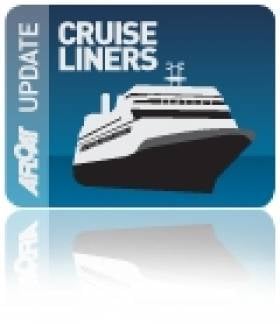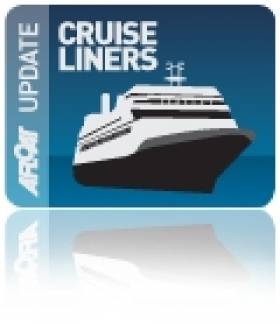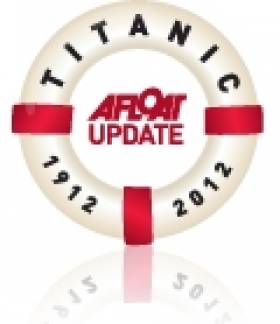Displaying items by tag: National Geographic
#WestIslandsCruising - Two former Norwegian 'Hurtigruten' Coastal Express Voyage ships today visited the west coasts of Ireland and the UK, where passengers on board experienced totally contrasting scenery, writes Jehan Ashmore.
Anchored off the Dingle Peninula Co. Kerry this evening is National Geographic / Lindblad Expedition cruises small ship National Geographic Explorer (1982/6,471grt) which arrived from the Isles of Scilly.
The former Lyngen which took on other names since becoming a full-time cruise ship is understood to be calling next to the stunning Skelligs that pierce out of the Atlantic.
Having boarded the 'Explorer' during an anchorage call off Inishmore, Aran Islands in 2008, the on board library been of National Geographic Magazine fame was not surprisingly well-stocked!
While making this ship visit, it was particularly noted how rebuilt the former Norwegian coastal cargo-car-carrying ferry/cruise ship had undergone conversion. The ship prior to then had served the routine Bergen-Kirkenes circuit.
The work involved a new extended aft gym structure on the top-deck. Also the fitting of a stability ducktail sponson at the stern which dipped up and down in the swell offshore of the island's Kilronan Harbour.
A Hurtigruten vessel that is currently in the fleet, Fram (2007/11.647grt) which unlike her counterparts is designed primarily as a polar expedition cruiseship was in nearby waters of the Natiional Geographic Explorer. As the 418 passenger vessel had anchored in Galway Bay off the city at the end of last month.
As for the second former Hurtigruten ship, Serenissima (1960/2,598grt) which today visited the Scilly Isles, the low-lying archipelago off the Cornish coast. This former fjord fleetmate was the Harald Jarl that in her current role had anchored off St. Mary's the main island. It is also understood she is to be making a next port of call across the English Channel to St. Peter Port, Guernsey.
Serenissima was particularly smart (see photo) when within Dun Laoghaire Harbour in 2013 and year one after the revived cruise business began. She berthed at the Carlisle Pier while on the same day of Serenissima Cruises port call in stark contrast the giant Cunard flagship liner, Queen Mary 2 anchored on her maiden call off the south Dublin Bay harbour.
This evening Royal Princess which called to Cobh is underway. It will be the turn of the Princess Cruises 3,600 passenger caller as previously reported to make her maiden visit off Dun Laoghaire Harbour in the morning.
Irish Marine Scientists Discover 'Smoking Vents' on Mid-Atlantic Ridge
#UCC – Irish research which led to the discovery of smoking vents on the mid Atlantic Ridge will feature in a National Geographic programme to be broadcast next Sunday, 28 October.
National Geographic has produced a five part series, The Alien Deep, which takes viewers into underwater worlds where no human has gone before.
The programme will be broadcast this Sunday 28th October at 6pm on National Geographic channel on Sky (channel 526) and also UPC (channel 215). The programme presenter is Dr Robert Ballard, famed explorer who found the Titanic at its final resting place.
The series takes viewers into an underwater world 3,000m deep, where, on the slopes of the Mid-Ocean ridges that divide the earth's tectonic plates, chimney- like formations spew black plumes of superheated water packed with chemicals, minerals and dissolved gases allowing life to thrive against the odds. The leader of the scientific team was Dr Andy Wheeler, School of Biological, Earth and Environmental Sciences at University College Cork who worked with scientists from the National University of Ireland Galway, Geological Survey of Ireland, the University of Southampton and the National Oceanography Centre in the UK. "It's great to see Ireland's expertise recognised on TV", says Dr Wheeler. "Discovering a new volcanic landscape three km below was a thrill."
The scientists were on board the Irish National Research Vessel, Celtic Explorer and used the Remotely Operated Vehicle Holland 1 for their explorations of the deep and was supported by the Marine Institute under the 2011 Ship-Time Programme of the National Development Plan.
The team named the previously uncharted field of hydrothermal vents along the Mid-Atlantic Ridge, the first to be explored north of the Azores, the Moytirra Vent Field. Moytirra is the name of a battlefield in Irish mythology, and appropriately means 'Plain of the Pillars'. Patrick Collins from the Ryan Institute, NUI Galway led Ireland's marine biological team on the surve
#FORMER IRISH PRESIDENT ON CRUISE – Former President of Ireland, Mary Robinson was a guest speaker on board the National Geographic Explorer during the first leg of a 14-day 'Exploring the British Isles and Irish Isles' cruise which departed the UK last week, writes Jehan Ashmore.
The theme of the lecture was about the perspective and context of 'modern' Ireland which formed part of the 'Global Perspective Programme' organised by the cruise operator Lindblad Expeditions.
Robinson who was also a former UN High Commissioner for Human Rights was also a guest speaker on the same vessel a year ago, where she shared her insights on what was then the recent historic visit of Queen Elizabeth II to Ireland.
The 148 passenger cruiseship is today on the start of an itinerary of the western Scottish Isles, having passed yesterday evening the 2,000-foot Slieve League, the highest sea-cliffs in Europe. The 6,471 tonnes vessel departed Killybegs from where her guests travelled to Glencolumbkille.
In addition she had anchored earlier in the morning between Inishmurray Island and Grange, Co. Sligo. The 228-acre island which has a 6th century monastery was inhabited until abandoned in 1948.
Since the cruise began in Portsmouth the vessel has called to several locations and the Irish west coast to the Skelligs, Dingle Peninsula, Kilronan on Inishmore of the Aran Islands and Cliffs of Moher.
It is to such destinations that are typically visited by Lindblad Expeditions in partnership with the National Geographic Society (NGS) which produces the renowned monthly magazine. At isolated and more inaccessible destinations passengers make shore excursions using Zodiac tenders.
In addition to hosting forums such as the Global Perspective Programme, the strategic alliance with NGS enables renowned experts from the society scientists, naturalists and photographers to accompany guests on visits to field sites that include those committed in sustainable geo-tourism.
National Geographic Explorer was built as Midnatsol in 1982 for Hurtigruten of the Norwegian Coastal Voyages. She is ice-strengthened and is the largest of the Lindblad fleet.
Several years ago the interiors were completely gutted-out in a Spanish dry-dock, resulting in an essentially different ship for her new role with many high-tech features and equipment incorporated. The most impressive being a remotely operated vehicle, or ROV, which can dive 1,000 feet below the ice.
Titanic As She's Never Been Seen Before
#TITANIC - Next month's edition of National Geographic magazine features startling images with the first ever complete views of the wreck of the Titanic.
The large-scale panoramas were produced by combining "thousands of high-resolution images" of the wreck on the North Atlantic sea floor, according to the Guardian - which has a sample gallery of the Titanic as it is today HERE.
Irish Lead Mission to Find New Life on the Ocean Floor
An Irish-led marine research mission has set off to discover strange new lifeforms that inhabit the deepest parts of our oceans.
In collaboration with scientists from the UK’s National Oceanography Centre, the team sailed from Galway earlier this week bound for the Mid-Atlantic Ridge to investigate life at 3,000m below the surface of the sea.
Using a remotely operated vehicle (ROV) they will explore for the first time the 45o North MAR hydrothermal vent field, where vents spew mineral-rich seawater heated to boiling point in the earth’s crust. These are home to a rich variety of marine life that thrives in complete darkness on bacteria fed by chemicals.
Patrick Collins from NUI Galway’s Ryan Institute will lead Ireland's marine biological team investigating this unique ecosystem, which could tell us not only about how life might have evolved on other planets, but may also be a rich source of new biochemical processes with valuable medical and industrial applications.
"There is potential here to put Ireland on the global map as a serious player in deep sea science," said Collins. "This is all the more timely with the exploitation of deep sea and hydrothermal vents for precious metals and rare earth minerals now a reality.”
The mission carries geochemists, marine biologists, marine geologists, marine geneticists and technicians from Ireland and the UK as well as a three-person TV crew from National Geographic.
They will spend 25 days at sea and will be posting a regular blog on scientistsatsea.blogspot.com.



































































